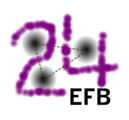Speaker
Description
The JISP16 nucleon-nucleon force [1] arise from the Inverse Scattering Methods and was proposed as an alternative to the standard models of two-nucleon interactions. It provides a sufficient convergence of the no-core shell model [2] calculations enabling accurate predictions for nuclear binding energies and spectra of excited nuclear states with established extrapolation techniques [3–5] and the ability to perform calculations of nuclear matter properties [6]. The description of the properties of light nuclei by JISP16 is also quite satisfactory [7,8]. However, the recent application of the JISP16 force to the nucleon-deuteron elastic scattering [9] revealed some drawbacks of this force, especially regarding P-waves components of the JISP16 potential. It occurs that the bound and excited states energies, used to fix free parameters of the JISP16 model are not enough sensitive to the P-waves contributions. In order to improve the JISP16 model additional fitting, preferably taking into account nucleon-deuteron scattering observables, should be performed. In this contribution we check if the nucleon induced deuteron breakup reaction can be useful in this context.
We applied the JISP16 potential [1] to investigate the nucleon induced deuteron breakup reaction at energies E=13 and 65 MeV. The formalism of Faddeev equation [10] was used. Our study reveals that the JISP16 interaction delivers, in general, qualitatively a similar description of the exclusive cross section and the nucleon analyzing power for the studied reaction to the one based on the standard realistic nucleon-nucleon AV18 interaction [11]. However, in some regions of the phase space the differential cross section based on the JISP16 and on the AV18 forces differs by more than 100% and 50% at E=13 and E=65 MeV, respectively. In the case of analyzing power – this difference also exceeds 100% at E=65 MeV. Such specific parts of the phase space can be used to fine-tune the JISP16 potential parameters.
References:
[1] A. M. Shirokov, J. P. Vary, A. I. Mazur, and T. A. Weber, Phys. Lett. B644, 33 (2007).
[2] B. R. Barrett, P. Navratil, and J. P. Vary, Prog. Part. Nucl. Phys. 69, 131 (2013).
[3] P. Maris, J. P. Vary, and A. M. Shirokov, Phys. Rev. C 79, 014308 (2009).
[4] S. A. Coon, M. I. Avetian, M. K. G. Kruse, U. van Kolck, P. Maris, and J. P. Vary, Phys. Rev. C 86, 054002 (2012).
[5] S. A. Coon and M. K. G. Kruse, Int. J. Mod. Phys. E 25, 1641011 (2016).
[6] A. M. Shirokov, A. G. Negoita, J. P. Vary, S. K. Bogner, A. I. Mazur, E. A. Mazur, and D. Gogny, Phys. Rev. C 90, 024324 (2014).
[7] A. M. Shirokov, V. A. Kulikov, P. Maris, and J. P. Vary, in NN and 3N Interactions, edited by L. D. Blokhintsev and I. I. Strakovsky (Nova Science, Hauppauge, NY, 2014), Chap. 8, p. 231, see https://www.novapublishers.com/catalog/product_info.php?products_id= 50945.
[8] P. Maris and J. P. Vary, Int. J. Mod. Phys. E 22, 1330016 (2013).
[9] R. Skibiński et al., Phys. Rev. C97, 014002 (2018).
[10] W. Glöckle et al., Phys. Rept. 274, 107 (1996).
[11] R. B. Wiringa, V. G. J. Stoks, and R. Schiavilla, Phys. Rev. C51, 38 (1995).
